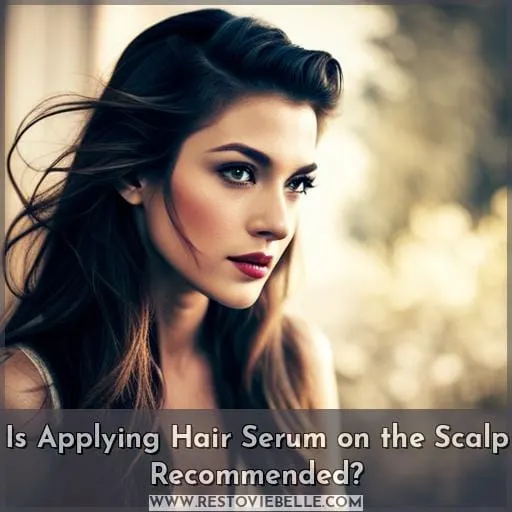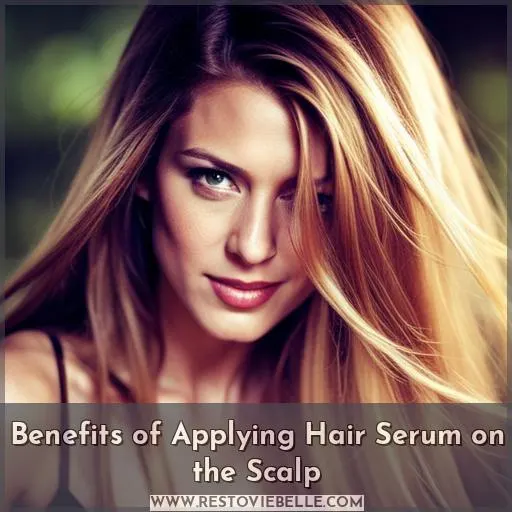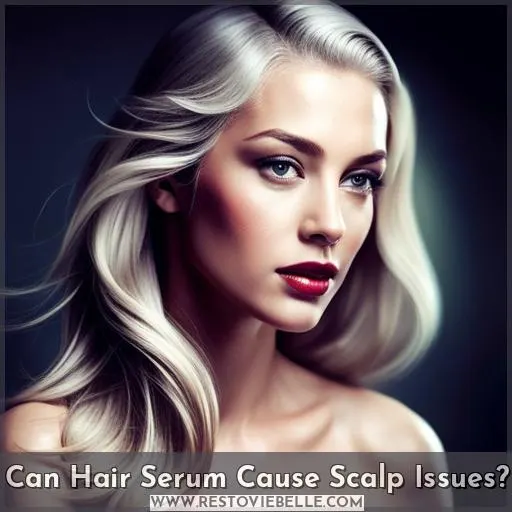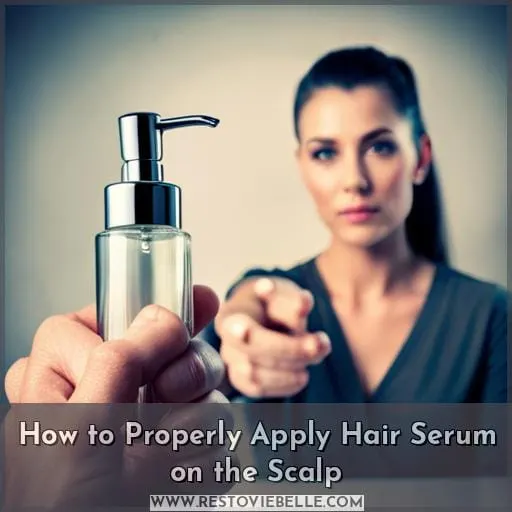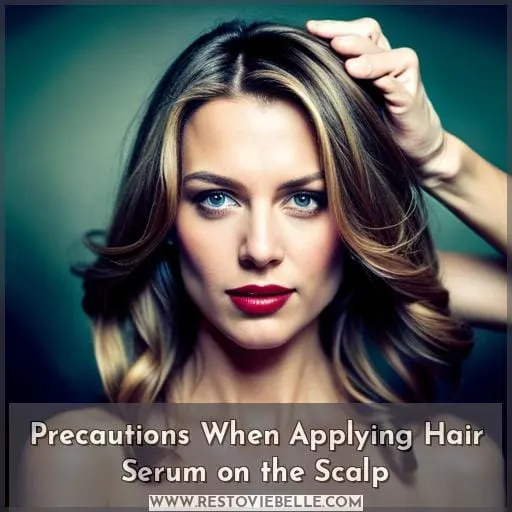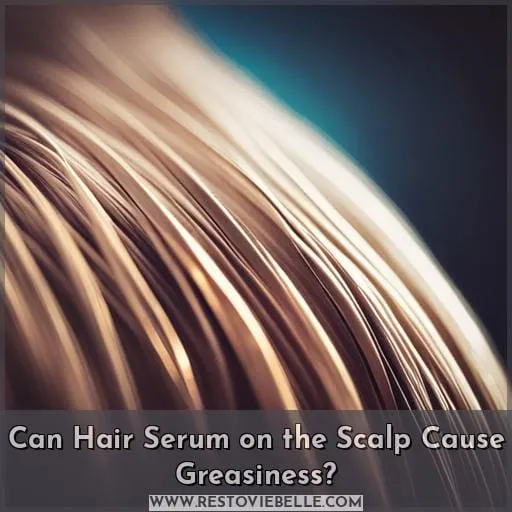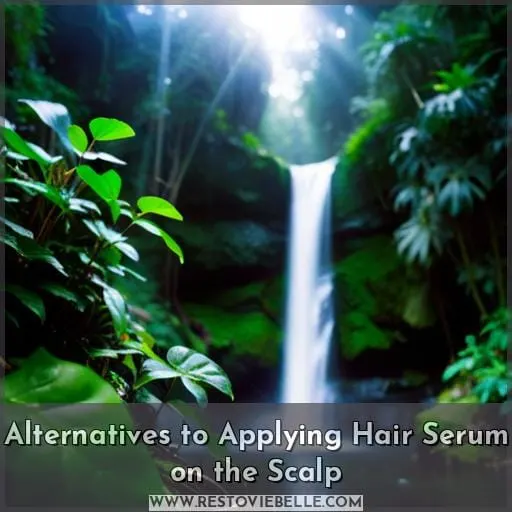This site is supported by our readers. We may earn a commission, at no cost to you, if you purchase through links.
 Sick of your unruly, frizzy hair? You’re not alone. We all want smooth, sleek, lustrous locks, but for some of us, taming flyaways and frizz seems impossible.
Sick of your unruly, frizzy hair? You’re not alone. We all want smooth, sleek, lustrous locks, but for some of us, taming flyaways and frizz seems impossible.
You’ve likely heard how well serums can nourish hair and enhance shine. But can applying hair serum on your scalp promote healthier growth? The answer is yes – with some caveats. Used properly, hair serum stimulates follicles and improves scalp health. But incorrect use may lead to greasiness and buildup.
We’ll walk you through choosing and applying the right serum for your hair type. With some knowledge and experimentation, you’ll unlock the secret to maximizing the benefits of hair serum while avoiding potential downsides.
Read on to master the art of hair serum!
Table Of Contents
- Key Takeaways
- Is Applying Hair Serum on the Scalp Recommended?
- Benefits of Applying Hair Serum on the Scalp
- Can Hair Serum Cause Scalp Issues?
- How to Properly Apply Hair Serum on the Scalp
- How Much Hair Serum Should You Use on the Scalp?
- Can Applying Hair Serum on the Scalp Promote Hair Growth?
- Precautions When Applying Hair Serum on the Scalp
- Can Hair Serum on the Scalp Cause Greasiness?
- Alternatives to Applying Hair Serum on the Scalp
- Conclusion
Key Takeaways
- Hair serum can help strengthen and nourish hair follicles, but it may clog pores or irritate sensitive scalps.
- Natural oils like jojoba are gentler alternatives that can nourish the scalp without buildup.
- Focus serum application on hair lengths and ends, avoiding direct contact with the scalp.
- Scalp massage with serum may improve circulation and nourish hair follicles.
Is Applying Hair Serum on the Scalp Recommended?
Are you wondering if it’s okay to use hair serum on your scalp? While its benefits are well known when applied to the ends of hair, applying it directly onto the scalp can be a little more complicated.
The main issue is that serums contain many silicones and other ingredients that may clog pores or cause irritation. Additionally, using a product too close to the root could lead to greasiness and weigh down your style quicker than usual.
However, some experts suggest taking advantage of certain natural oils like jojoba oil that can improve moisture levels in both skin and strands without being too heavy for fine-textured tresses. You’ll want to apply these oils sparingly, though, as they still possess emollient properties that will attract dirt from pollution faster than clean locks would normally do.
Plus, overusing them will make styling difficult since they’re thicker in texture compared with traditional silicone-based serums.
To reap all potential benefits without any drawbacks associated with direct application on roots, alternate between shampooing with an appropriate cleanser followed by conditioning afterward rather than relying solely upon hair serum as part of your haircare routine after every wash.
Benefits of Applying Hair Serum on the Scalp
Are you looking for a way to nourish and stimulate your hair follicles while improving scalp health? Applying hair serum on the scalp may be just what you need. Hair serums are designed to penetrate deep into the follicle, providing essential nutrients that can help with growth and the overall healthy development of strong, lustrous tresses.
Scalp Health Benefits
For smoother hair, condition the scalp twice weekly with coconut oil. Gently massaging serum into the scalp boosts blood flow, nourishing hair follicles and promoting growth. Choose lightweight, non-greasy formulas to nurture without weighing down. Regular scalp care with natural oils keeps follicles strong, allowing hair to thrive.
Stimulates Hair Growth
Your locks will flourish because you massaged that elixir into your crown daily.
- Rejuvenating scalp massage
- Agitates follicles
- Increased blood circulation
- Proper nutrition for hair
Rubbing hair serum into the scalp can promote growth by improving blood flow and nourishing the hair follicles. Massaging the scalp increases circulation, which brings more nutrients to the follicles for healthy new growth.
However, be mindful of greasiness. Focus serums on the lengths and ends instead of directly on the scalp.
Nourishes Hair Follicles
Nourish your hair follicles with a hair serum for stronger, healthier locks. Gently massage the serum into your scalp to boost circulation and nourish each strand. Focus the application on the scalp itself, not just the lengths. This stimulates each follicle for optimal hair growth.
Prevent greasiness by using just a few drops. Scalp health is essential for growing shiny, thick hair. Regular scalp massages with the serum enhance density and strength. Nourishing your follicles prevents thinning and dryness.
Can Hair Serum Cause Scalp Issues?
You’d best steer clear of serums on your scalp as they could inflame or over-oil it.
- Rubbing oily serums into your scalp can clog follicles and impair growth.
- Prolonged use risks irritating sensitive scalps prone to dermatitis.
- Oil buildup from serum use attracts dirt and causes inflammation.
Applying hair serum directly to the scalp risks greasiness, irritation, and clogged pores. It is best to focus application on the lengths and ends of your hair to hydrate locks, fight frizz, and protect from heat styling without compromising scalp health.
While some hair growth formulas contain serums, rubbing straight oil into your scalp is not recommended.
How to Properly Apply Hair Serum on the Scalp
Choosing the right hair serum and applying it properly to your scalp is a crucial step in maintaining healthy, manageable hair. First, make sure you pick a product that works with your particular needs and concerns.
Then, section off areas of the scalp where you want to apply the serum before taking some of it onto your palms and massaging it into those sections.
Step 1: Choose the Right Hair Serum
Choosing the right hair serum for your specific hair type and concerns is essential to get the best results. Take into account scalp benefits, potential greasiness concerns, and desired effect when picking a product.
Ensure you massage it in for maximum absorption so that it can also help with promoting healthy hair growth.
Step 2: Section Your Hair
Before massaging in the serum, partition your hair into sections for easier application and even distribution. First, divide your hair horizontally into layers. Next, section your hair vertically into parts.
This allows for precise scalp serum application to every area. Ensure the serum coats each strand without overapplying, which can lead to greasy buildup. Varying application depth and using your fingertips to gently work the product in helps absorption without excess.
Step 3: Apply the Serum to the Scalp
Carefully distribute the serum’s nourishing oils across your crown using gentle, circular motions. Scalp benefits include stimulation of hair growth, improved circulation, and scalp massage. Concerned about greasiness? Alternatives to scalp application are available: apply a few drops in your hands before smoothing it onto dry hair ends or misting it on wet strands after showering.
Step 4: Massage the Serum Into the Scalp
Gently work the serum into your scalp with the pads of your fingers using small, circular motions to help it penetrate. Massaging benefits scalp health by nourishing hair follicles, stimulating growth, and preventing greasiness when properly applying serum in this step.
Varying the motion and pressure as you massage can boost circulation. Take care not to over-rub, as too much friction may cause irritation. Focus on massaging areas that need stimulation, like the hairline, crown, and temples.
Massage thoroughly but gently for a minute or two until the product is absorbed.
Step 5: Style Your Hair as Desired
You’ll be stylin’ once you finish up. With hair serum applied to your scalp, style your hair as desired. Follow stylist tips for your hair type. Enjoy the scalp benefits and hair growth effects.
How Much Hair Serum Should You Use on the Scalp?
- Start with a pea-sized amount. Rub it between your palms to warm and spread it before applying.
- Focus just on your hair length, avoiding direct contact with your scalp. The skin on your scalp is very absorbent and applying serum can lead to a greasy buildup.
- If you must apply serum to your scalp, use the tiniest amount and really work it into the skin with a massage.
- Monitor yourself for any irritation, itching or accelerated hair fall that can result from product buildup on the scalp.
- Use dry shampoo on off days to soak up excess serum on your scalp. And shampoo regularly to remove all traces of product so pores can breathe.
Can Applying Hair Serum on the Scalp Promote Hair Growth?
Massaging the scalp with a serum infused with growth-boosting ingredients like peppermint and rosemary oils can stimulate follicles and increase circulation for stronger, thicker hair over time. When selecting a serum, opt for lightweight formulations to avoid greasiness on the scalp.
Look for serums with natural oils like argan, jojoba, and coconut that nourish hair without clogging follicles.
While hair serums are not formulated for direct scalp application, you can make DIY versions with thinning carrier oils. Focus the massage on stimulating blood flow, and maintain scalp health by regularly exfoliating and avoiding buildup.
Consistent scalp massages can boost circulation, but hair growth depends on internal factors like genetics, hormones, and nutrition.
Ultimately, a healthy scalp and follicles are key for optimal growth.
Precautions When Applying Hair Serum on the Scalp
Many people wonder if they can apply hair serum directly to their scalp to promote hair growth. Although using hair serum on the lengths of your hair provides nourishment, applying serum to your scalp can lead to irritation and greasiness, issues you will want to avoid.
Directly putting serum on your scalp may cause problems. The scalp is sensitive, so products not made for it can create irritation. Additionally, your scalp naturally produces oils, so adding more through serums risks making it overly greasy.
For healthy hair growth, focus hair serums only on the lengths and ends. Using them properly conditions these parts that weather daily damage from styling, sun exposure, and other factors. If your scalp needs extra care, look for products specifically formulated for that sensitive area.
With the right routine, you can nourish your hair and scalp without causing adverse effects.
Avoid Using Too Much Serum
Don’t drown your tresses in serum, friend; less is more. Avoid saturating those luscious locks – too much product weighs hair down. Believe me, a few dime-sized drops go a long way toward sleek, glossy hair without leaving strands greasy.
Focus the serum on ends and lengths, not roots, for touchable texture and radiant shine. Moderation allows serums to work their magic, transforming lackluster hair into a crowning glory.
Test the Serum on a Small Patch of Scalp
You would be wise to spot test any new hair serum on a small part of your scalp before applying it all over. Apply a dime-sized amount to your scalp and let it sit for a day to check for any irritation or excess grease before using it on your entire scalp.
Monitoring a test patch also helps optimize the use of the serum for promoting hair growth without weighing it down. By carefully testing hair serums, you can enjoy the benefits for your scalp without the drawbacks of oiliness.
Discontinue Use if Scalp Issues Occur
If you notice scalp issues after applying serum, stop using it immediately. Greasiness, rashes, irritation, flaking, or itching are signs something’s not right. Over-application and incorrect serums cause buildup and clogged follicles, hindering hair growth.
Discontinue use of that serum to allow your scalp to breathe and recover. Consult a trichologist if issues persist despite discontinuing the serum. Properly chosen lightweight serums applied correctly should not cause scalp problems.
Can Hair Serum on the Scalp Cause Greasiness?
The greasy wolf creeps toward your crown, oiling each strand. Though hair serum brings shine, overdoing it on the scalp causes greasiness. Massaging serum into the scalp seems luxurious yet can clog follicles. Seek hair health not vanity.
Let serum smooth tresses while gentle fingertips stimulate below. Or, create scalp elixirs sans goop—botanical oils protect tender skin and spur growth. Excess serum above over-oils fine strands. But used wisely, this tool conditions and completes your look.
Discover balance. Shine comes from within—treat all parts with care. Greasy roots dim your inner light.
Alternatives to Applying Hair Serum on the Scalp
While promoting hair health, focus the serum on the lengths and ends rather than directly on the scalp. Excess oiliness occurs when serum is applied to the roots, so focus the application on the mid-lengths and ends.
Opt for lightweight, non-greasy formulas catered to your hair type. Stimulate growth by gently massaging your scalp while washing your hair. For scalp nourishment, use natural oils like coconut, olive or almond directly on the roots and massage in.
Alternatives like DIY hair masks with yogurt or apple cider vinegar can provide scalp benefits without greasiness. Remember to thoroughly cleanse your hair after oil application and use serum only on damp, washed strands for optimal results.
Conclusion
You’ve likely wondered if applying hair serum to your scalp can actually help your hair grow. The truth is, when used properly, hair serums can provide scalp health benefits that stimulate growth and nourish follicles.
However, misuse may lead to irritation or clogged pores. When applying serum to your scalp, use just a small amount of lightweight, non-greasy product formulated for this purpose. Gently massage it in and avoid overdoing it. With the proper product and technique, hair serum on your scalp can promote healthy, lush locks.
